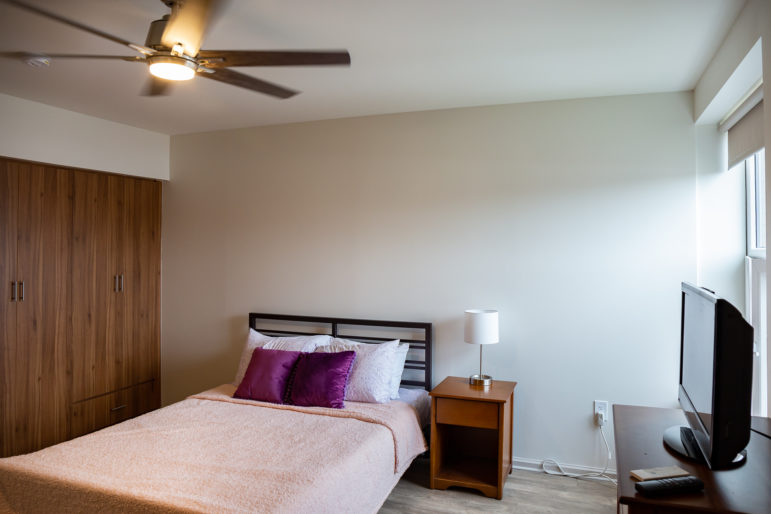“For many nonprofit building owners like us, it is not a question of if we will be able to keep these buildings as supportive housing; rather, it is a question of how long we can afford to.”

Adi Talwar
A supportive housing apartment in Manhattan.When Caesar escaped an abusive domestic relationship with his three children in 2020, he and his family desperately needed two things: A safe, affordable place to call home and services to help rebuild their lives after years of abuse and trauma.
After bouncing between three different homeless shelters, they found all of that—and more—at a New Destiny building funded by a state program, the Empire State Supportive Housing Initiative (ESSHI).
Thanks to ESSHI, Caesar, 43, and his kids—Tristan, 17; Brandon, 14; and Bella, 12—have an apartment of their own with security to keep them safe and on-site trauma-informed staff to provide them with services like mental health counseling, therapeutic activities, financial coaching, and a variety of classes and events that are helping them build a new community and begin to heal from the double trauma of abuse and homelessness.
They are all hard at work and already flourishing. Caesar recently enrolled in university, and the kids are thriving in school. Every domestic violence victim in New York should have this kind of success story. And supportive housing, which is designed to help families like Caesar’s, should be an essential tool in making those stories possible.
But sadly, many supportive housing buildings are not able to reach their full potential in the way that those that receive ESSHI funding can. And it has nothing to do with the work of the passionate staff who work tirelessly to make those outcomes happen. It is because thousands of properties are stuck in an outdated funding model, known as the New York State Supportive Housing Program (NYSSHP), which hasn’t seen a significant increase in financial support since its inception more than three decades ago.
Many NYSSHP buildings are one crisis away from going irreversibly into the red, and most supportive housing providers cannot continue to afford to pay for the buildings’ costs via mostly philanthropic contributions. For many nonprofit building owners like us, it is not a question of if we will be able to keep these buildings as supportive housing; rather, it is a question of how long we can afford to.
The situation is dire. NYSSHP provides no rental subsidy and annual service funding of just $2,736 for individuals and $3,672 for families, compared to ESSHI’s annual rate of $25,000 per household. With few exceptions since the NYSSHP program began in 1987, all cost-of-living adjustments to staff salaries have had to be self-funded by nonprofits without reimbursement, increasing the financial burden on us in perpetuity. Vulnerable tenants still struggling with the emotional, mental, and financial impacts of domestic abuse, as well as underpaid social services staff, are most impacted by this significant funding disparity.
A simple solution exists: The governor and state lawmakers can convert the 9,000 antiquated NYSSHP units into ESSHI units and create fiscal equity in the supportive housing system. The cost to the state is a rounding error, given its annual budget of $229 billion. That’s a small price to pay to protect thousands of New York’s most vulnerable households while shoring up investment in these buildings by keeping them affordable to low-income New Yorkers.
At New Destiny, NYSSHP provides, on average, just $86,000 per building annually. That barely covers the salary and benefits of one staff person, leaving us to fundraise for the entire security staff and enough case managers to meet the various needs of our survivors and their children. This is an impossible feat that always leaves both us and our residents significantly understaffed and less secure.
According to the most recent statistics, 39 percent of families using the NYC Department of Homeless Services shelter system identify domestic violence as the cause of their homelessness. It is the number one reason for family homelessness in New York City. How can we begin to meet this need for housing and services if we’re spending all our time and resources fundraising to support the families we’ve already housed?
We’ve seen the power of the ESSHI model in action with Caesar and his family, as well as with countless other inspiring domestic violence survivors with whom we have had the privilege of working over the years as they chart successful new chapters in their lives.
Every New Yorker in a similar situation deserves the chance to experience the benefits a fully funded supportive housing program can bring. The path to making that possible is clear: It is incumbent on the governor and state lawmakers to bring NYSSHP in line with ESSHI in next year’s budget.
Nicole Branca is executive director at New Destiny Housing Corporation, a New York City nonprofit founded in 1994 to provide permanent housing and services to survivors of domestic violence and their children.








